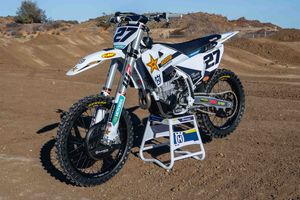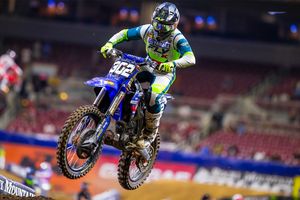MotoOnline.com reviews the new 2026 Ducati Desmo450 MX.
When a premium brand like Ducati enters motocross, it’s impossible not to take notice. Following the unveiling of the all-new 2026 Ducati Desmo450 MX, MotoOnline was on location at 04 Park Monte Coralli located in Faenza, Italy, for a world-first test as part of the global press launch for this Tested review.
Leading into the test, I was feeling a mix of excitement and nerves. With no real off-road heritage to draw from, I had no idea what to expect from Ducati’s first motocross bike, but considering the manufacturer’s success in just about every other form of racing, I had a quiet confidence that the Desmo450 MX would have something special to offer – learn more about it in Detailed.
Let’s get to it! What is the 2026 model Desmo450 MX actually like to ride on track? With the static and rider sag set to 38/102 millimeters, the handlebars and levers dialed in and a full tank of fuel, I hit the track with a sense of curiosity and anticipation.
Straight out of the pits, the track opened with a long uphill section. Keen to feel what the Desmo450 MX had to offer, I got straight into it and wound the throttle on without a second thought – just like that, I was experiencing Ducati power for the first time on dirt.
Beginning with the engine, this package is – without a doubt – the most impressive production motocross engine I’ve ever ridden. Yes, it’s powerful, but in a way that feels unique. The Desmodromic system gives it a character of its own, producing more torque at lower RPM and maintaining a smooth delivery all the way through the rev range.
There’s none of that sharp drop-off when you hit the limiter, because instead, it transitions cleanly into the next gear, delivering an incredibly usable power curve. As someone who usually rides a 450 in third gear just about everywhere, I did have to make some adjustments to my riding.
The Desmo450 MX comes standard with 13/49 gearing, which isn’t out of the ordinary, but it stood out to me immediately. I found myself needing second gear in the tighter corners, while third still worked well in the faster, sweeping turns. Even then, second gear was longer than I expected – offering great bottom-end and strong over-rev. Put simply, second gear had the length and pull I’d usually expect from third.
From what I gathered, both Tony Cairoli and Alessandro Lupino – two riders largely behind Ducati’s motocross development – have been experimenting with different gearing. Tony was running 14/51 on his bike, which also had an Akrapovic exhaust and other upgrades. He said he also prefers to ride in third gear, so I found it interesting that he opted for 14/51 over 13/49, considering how close the two ratios are.
On other bikes, I’ve found that increasing the countershaft sprocket size makes the power more manageable off the bottom and improves the way the chassis handles braking bumps, so if I had this bike in my garage, the first thing I’d want to try is going from 13/49 to 13/52. It’s a big jump, but one I’d test before going to a 14-tooth on the front.
Suspension-wise, the Showa fork and shock are solid. Potentially a little firmer than most production bikes, but with only a few minor changes, I found the balance pretty spot-on. The front felt a little overloaded off-throttle at first, like it wanted to dive, so I bumped the rear sag from 102 to 105 millimeters, and the geometry felt much more natural for my style.
After that, I went two clicks stiffer on compression at both ends, and after a few more changes here and there, I found myself going back to that setting as my base.
What surprised me most was how sensitive the bike is to these small changes. Three millimeters of sag might not sound like much, but it made a noticeable difference. Plus, going just two clicks firmer on low-speed compression delivered more support right where I needed it in the turns.
The frame stood out straight away. Made up of just 11 elements – a lot less than what you’d find on most 450s – it’s clearly taken inspiration from Ducati’s superbike background. The layout helps centralize mass and gives a solid balance between stiffness and flex.
It feels light, easy to move around on, and is apparently very simple to work on thanks to the clean design. Paired with the bolt-on aluminum sub-frame, the chassis feels planted and predictable, especially under brakes and through rough, choppy sections.
Ergonomically, I was pleasantly surprised, since the rider triangle feels really neutral, especially when I was entering a turn on the pegs. Ducati also runs unique plastic frame guards with directional grip, designed to hold you in under acceleration, but release under braking. Did I notice it? Not really, but I had no issues gripping the bike either. It’s a clever little touch.
If I were to change anything ergonomically, it’d be the seat. As a taller rider, I found the dip in the middle a bit too deep, making it difficult to stay forward coming out of corners – a flatter seat would definitely suit me better. I’d also change the handlebars to my personal preference, but overall, as a production bike straight off the showroom floor, the layout is comfortable and easy to ride.
Moving over to the ECU, I was somewhat hesitant to try the traction control at first, because I’d never really gelled with it on any dirt bike, but Ducati’s system impressed me. Running TC on the aggressive map, I found it really effective, especially in hard-pack or marbly corners. It lets you stay on the throttle confidently, removing some of the mental strain in sketchy sections.
Traction control is not something I’d usually give the time of day to in stock trim, but I feel like Ducati has produced a system that’s going to be usable for high-level racers, too. I can see it being an asset on certain surfaces – even at the professional level. Note also that with a simple flick of the clutch, traction control can be disabled for a matter of seconds where you need it to be.
There are also standard and aggressive maps to choose from, with further tuning available through a specifically-developed tuning app. I didn’t get a chance to dive into features like engine braking settings, but if I had more time with the bike, that’d be something I’d be keen to explore properly. The bike also comes with a quickshift feature – not really my thing, but some riders might appreciate it.
Its Brembo clutch and braking package is top-tier, with the only real difference from what we typically see on KTMs being the use of Galfer discs front and rear instead of Brembos – something I found interesting, though performance-wise there was no noticeable difference. For me, this set-up is a definite highlight. I’ve always appreciated the Brembo braking feel, so it’s ideal to see Ducati going in a similar direction.
Tire-wise, the Desmo450 MX comes with Pirellis – 80/100-21 up front and a 110/90-19 on the rear. The tires worked well, but I would’ve loved to try a 120 on the rear just to see how it feels on those hard-pack conditions. Personally, I usually like the 120 rear on a 450, but that’s really personal preference.
Overall, the Desmo450 MX is a seriously impressive first attempt in the market for Ducati. Borgo Panigale has entered motocross with clear intent, and there’s no question this bike is going to be competitive straight out of the crate. It’s exciting to have another manufacturer entering the mix, especially being Ducati with its significant MotoGP and World Superbike credentials.
A huge thanks to everyone at Ducati for an unforgettable few days. From exploring Bologna and visiting the Ducati Museum, to watching the first Desmo450 MX roll off the production line, and being among the first in the world to ride it – it’s an experience I won’t forget any time soon.
Specifications
Engine type: 449.6cc single-cylinder Desmodromic engine
Bore/stroke: 96.0mm x 62.1mm
Transmission: Five-speed
Starter: Electric
Clutch: Brembo hydraulic, multi-plate wet clutch
Front suspension: 48mm Showa coil-spring fork
Rear suspension: Showa shock with linkage
Front brake: Brembo caliper with 260mm Galfer disc
Rear brake: Brembo caliper with 240mm Galfer disc
Tires: Pirelli Scorpion MX32
Weight: 231 lbs (without fuel)
Price: $11,495
Availability: July 2025
Further information: www.ducati.com
Recent

Detailed: 2026 Husqvarna FC Factory Edition range

BarX Yamaha names updated new 2026 team roster










